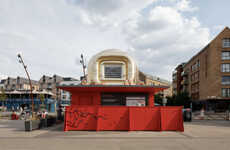
MIT Media Lab is Testing Innovative Modular Tiles for a Project
Kalin Ned — June 1, 2022 — Art & Design
References: dezeen
MIT Media Lab researchers are pioneering innovative modular tiles that promise to reimagine the state of space architecture. The project, which is titled Tesserae, aims to tease out possible methods for creating sustainable space habitats. The innovative modular tiles that MIT Media Lab is testing are engineered to autonomously assemble "while in orbit around the moon or Earth." The researchers are quite ambitious about the implications of the Tesserae project, stating that the tiles can be utilized to create "geodesic dome habitats, [...] microgravity concert halls, [and] space cathedrals."
The tiles are 3D printed and have a rigid outer shell, as well as a mechanism to harvest power. Each piece has "two indented holes for electromagnets" and these work to autonomously snap—the bond will be watertight and weathertight—and create "tesselated structures."
Image Credit: Aurelia Institute / Igor Neminov
The tiles are 3D printed and have a rigid outer shell, as well as a mechanism to harvest power. Each piece has "two indented holes for electromagnets" and these work to autonomously snap—the bond will be watertight and weathertight—and create "tesselated structures."
Image Credit: Aurelia Institute / Igor Neminov
Trend Themes
1. Modular Space Architecture - The Tesserae project is showcasing the potential for utilizing modular tiles to create sustainable space habitats in orbit around the moon or Earth.
2. Autonomous Assembly - The self-assembling modular tiles represent a disruptive innovation opportunity for space architecture by reducing the need for human intervention during construction.
3. Power Harvesting Mechanisms - The innovative tiles feature power harvesting mechanisms that represent an upcoming trend for sustainable space architecture to reduce reliance on external resources.
Industry Implications
1. Space Exploration - The Tesserae project is providing a glimpse into the future of space architecture and the potential transformation of current space exploration practices.
2. Construction - The autonomous self-assembly of the modular tiles could disrupt traditional construction practices by providing a more sustainable and efficient method for building on Earth as well as in space.
3. Renewable Energy - The power harvesting mechanisms in the tiles have the potential to infiltrate various industries beyond space architecture and enhance renewable energy solutions in areas lacking infrastructure.
7
Score
Popularity
Activity
Freshness























